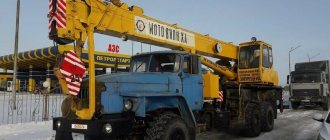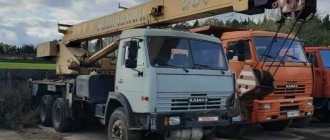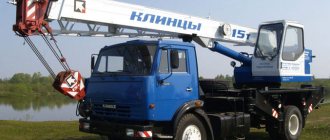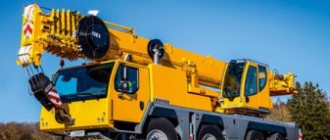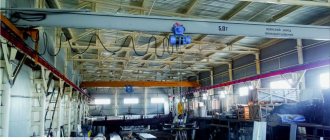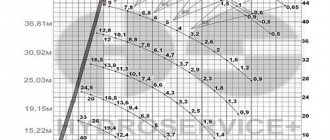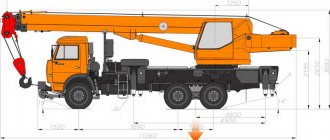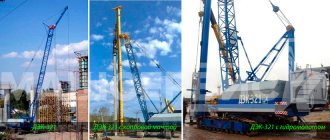Design Features
Each node performs its own functions.
Sections . The load-height characteristics of the equipment depend on their number in the telescopic boom. For truck cranes with lifting capacity up to 10 tons, two sections are sufficient. As the carrying capacity increases, another one is added. Four- and five-section models are installed on all-terrain cranes. They can also be equipped with an extension cord.
Telescopic boom
Section . In cross-section, the arrow usually has a rectangular profile, which is easier to assemble. However, its shape can be more complex, for example, trapezoidal, multifaceted or ovoid. With more complex, ovoid profile shapes, the multifaceted boom is equipped with clamps that help it withstand the entire load. The ovoid section became a real breakthrough in crane construction.
Tower arrow . Tower jib cranes are commonly used on high-rise construction sites. The peculiarity of the tower modification is expressed in its use as a support tower, and its direct function is performed by a horizontally directed beak at the end.
The crane boom is a triangular shape, the upper chord of which and the lattice rods are made of pipes, and the lower ones are made of channels
Lattice modification . This type is more complex. Despite the difficulty of their installation, they demonstrate greater load capacity than telescopic ones.
Additional details . During the lifting operation, the weight of the load is supported by cylinders. To transfer the load to the boom, special clamps are used. The functionality of all-terrain cranes is enhanced by extensions and jib joints.
Gusek . Many models are equipped with a jib extension, to the end of which another hook is attached. This structure looks like a refracted structure with two hooks. The use of a jib allows you to increase the load capacity without resorting to renting more expensive equipment. It is attached with hinges to the main boom of the truck crane when lifting heavy types of equipment - industrial equipment or antennas.
Classification of jib cranes
In appearance they can be:
Jib cranes
These are rotary-type machines that differ from others in the location of the load-handling mechanism - it is installed at the end of the boom. The latter can consist of 1, 2 or 3 sections, but it always has a significant reach - from 9.5 to 23.5 m or even more, due to the jib. Modern jib cranes are actively used at industrial construction sites, during the construction of bridges, laying railway tracks, gas and oil pipelines, performing loading and unloading operations, carrying out restoration and/or emergency work. They can be either mobile (mobile) or stationary.
Telescopic modification device with ovoid profile
The telescopic boom consists of:
Telescopic ovoid boom
- grounds;
- steel sliding sections;
- a mechanism for changing its length;
- devices that fix retractable segments.
To extend the sections, hydraulic cylinders and pulleys are used. To reduce the friction force when they extend, sliding plates are installed. Lateral movement of the extended parts is prevented by stops and pads. For effective operation and protection of parts from rust, anti-rust mastic is used; you can buy BKM mastic in specialized stores.
An important technical parameter is the profile of the telescopic boom. The invention of the ovoid section became possible with the development of computer technology. The upper, lower and side sections of the section of the retractable sections operate under different types of loads:
Ovoid profile of the boom of a truck crane
- the upper part experiences tension;
- lower belt – compression;
- the side parts are curved.
The ovoid profile became a combination of different geometric shapes - rectangular and ellipsoidal. Thanks to this connection, it received the name ovoid. The production of an ovoid section requires high-tech equipment and special grades of steel.
Ovoid arrows made it possible to significantly improve its technical parameters. Their advantages are:
- in high local resistance;
- low metal consumption;
- high safety margin;
- resistance to heavy loads, which allows you to increase their length.
Ovoid booms effectively withstand all types of loads, and today are successfully used in the production of jib cranes.
Mechanisms for lifting and changing the boom reach of cranes
Construction machines and equipment, reference book
Category:
Working equipment of a truck crane
Mechanisms for lifting and changing the boom reach of cranes
The 4056 crane has a cargo winch and a mechanism for changing the boom reach.
The cargo winch (Fig. 91) consists of a drum, a worm gearbox, a hydraulic motor and a brake. A drum with helical grooves is mounted on a shaft.
Rice. 91. Cargo winch of crane 4056:1 - body; 2 - worm; 3 - worm wheel; 4 - coupling; 5 - drum; 6 - shaft; 7 — brake band; 8 — brake pulley; 9 and 10 — brackets; 11 - spring; 12 - nut; 13 — lever; I - hydraulic brake release; 15 - plunger
One end of the shaft is installed in the bracket bushing, the other end is connected to the gearbox shaft through grooves on the end and a toothed splined coupling, centered on a ball joint. The spring maintains constant engagement of the gear coupling with the drum shaft.
The winch gearbox is a worm gearbox and consists of a housing, a worm and a worm wheel. The winch hydraulic motor is directly connected to the worm shaft.
The winch brake is a closed band type. The brake pulley is connected to the winch drum and is covered by two brake bands. The tapes at one end are fixed to the winch bracket through the ears and the axle; at the other ends they have rods with a screw thread at the end. Springs are placed on the rods passing through the holes in the bracket, creating tension on the tapes.
When the winch hydraulic motor is turned on, the hydraulic brake release mounted on the bracket is also activated. The hydraulic release plunger presses through the lever onto the adjustable cap nut attached to the end of the brake band rod and releases the brake drum.
When the winch is turned off, the plunger stops pressing on the lever and the drum slows down under the force of the springs acting on the belts.
The MKA-10G crane has two winches: a cargo winch and a jib winch. Winches consist of a drum, a gear reducer and a hydraulic motor.
The drum and gearbox are similar to the drum and gearbox of the cargo and jib winches of the MKA-10M crane.
Read more: Rotation mechanism of the rotating part of the crane
Category: – Working equipment of a truck crane
Home → Directory → Articles → Forum
stroy-technics.ru
Basic parameters
Arrows differ in their technical characteristics, which should be taken into account when choosing a model:
Main settings
- load capacity indicates the maximum weight that is permissible for a given type;
- its length is an important indicator, which is measured between the fifth and the extreme point of the head;
- the magnitude of the angle of movement;
- the boom radius is determined by the distance between the axes of the load and the crane installation, its value is the smallest at maximum lift;
- the lifting height of the hook can be calculated by knowing the reach and rise; this indicator is also affected by the presence of supports;
- units of measurement of the speed of movement of cargo – m/min.;
- departure modification time, that is, the period during which it moves in the opposite direction.
Main modifications
The first models of truck cranes were equipped with lattice solid booms on a cable suspension. When installing them, the hook and suspension are reinforced with strong cables. Thanks to the lattice design, they are distinguished by their low weight.
At the same time, telescopic booms formed by several retractable segments are most in demand today. The retractable design is highly flexible and can withstand significant loads. The maximum number of sections that domestic industry can produce today reaches five.
In many cases, it is more convenient to use cranes with tower booms, since they are distinguished by a significant lifting height. This type of equipment is used mainly in the construction of high-volume structures.
Telescopic models
The device of a telescopic boom and the operation of an all-terrain vehicle crane
With the expansion of the scope of use of self-propelled jib cranes, their working mechanisms began to improve. If the first models were equipped with lattice modifications with cable suspension, today truck cranes are equipped with telescopic booms. Their movable design allows not only to increase the load capacity of the truck crane, but also to move freely along the highway in the flow of ordinary cars.
Lattice models had a simple design; their production did not require complex technological operations. To lengthen it, special inserts were used, which required additional time and effort. With the advent of telescopic booms on hydraulic cylinders, a real revolution took place in the production of boom truck cranes.
Types of truck cranes by drive type
Various types of truck cranes can be powered by one or more motors. This is necessary in order to get more power without significantly increasing fuel consumption. Additional motors are installed on individual mechanisms or provide greater performance when working with high loads. For example, the largest truck crane in the world is equipped with four motors, the total power of which is 1490 hp. Such a machine is capable of lifting loads weighing up to 2000 tons at a time.
Accordingly, according to the type of drive, truck cranes are divided into the following types:
- single-engine;
- multi-engine.
Truck cranes can be divided into types and according to the operating principle of the drive. They are:
- mechanical;
- electrical;
- hydraulic.
Those types of truck cranes that are equipped with a mechanical drive are obsolete. Today, no new machines are produced, and only those that have retained their technical characteristics to this day remain in operation.
Electrically driven truck cranes have a generator set. Hydraulic - the most common. They have a hydraulic pump installed, through which the cylinders extend and fold and, as a result, control the boom mechanism.
We previously wrote about what types of tires there are for cars and trucks.
Providing truck crane services: when is it profitable to rent equipment, how to conclude an agreement
What types of burners are there: by fuel type, gas, by application, for boilers
Screw screw conveyors for bulk materials: device, characteristics, types of spiral conveyors
Metal cable trays: advantages, types, which ones to choose
Truck tire rating: for drive and steering axles, for semi-trailer with characteristics in the table
Renting a front loader with or without a driver: which is more profitable?
Which trailer is better - single-axle or two-axle: which one is more convenient, which one is better to choose for a car or truck
Caterpillars for special equipment: what advantages do they have over wheeled vehicles?
How to choose tires for special equipment: choose the right one
Diagnostics of Common Rail diesel injectors: types, faults, repairs
Productivity of jaw crushers: what it depends on, calculation formula
Methods of carrying cargo
Rigid boom of a truck crane
In lifting booms, the load is transferred simultaneously horizontally and vertically by increasing or decreasing the angle of inclination. Due to the design features, cranes with similar modifications are much lighter than other types.
The rigid boom type is characterized by a constant reach length during the operating cycle. The load is moved by the movement of the crane itself, as well as by the rotation of the lifting mechanism. To increase the reach, it is necessary to stop the operation of the truck crane.
In models with a cargo trolley, it moves horizontally. If it is necessary to increase the lifting height, the boom is placed in an inclined position, and a cargo trolley is attached to its end.
Lattice booms for mobile cranes
It is immediately worth noting that truck cranes with lattice booms are currently practically not produced. The telescopic hydraulic design has shown greater practicality and better performance. Despite the fact that the lattice boom has an increased lifting capacity compared to analogues, it is more difficult to install and cannot change its length.
The boom has a “skeletal” lattice structure and consists of steel rods, pipes or bars welded together. In this way, high mechanical strength is achieved while maintaining a low weight of the product. Each of the rods is a kind of “stiffening rib”. Due to the low weight and high mechanical stability of the boom, the truck crane has a high lifting capacity.
Image source: wikipedia.org
To manipulate the loads, a winch installed at the base of the boom is used. It is connected to the hook for grabbing loads via a block lifting mechanism. Some models of truck cranes use a special block design, in which the cable forms as if two or more loops - this ensures better transmission of mechanical torque and increases reliability when manipulating loads.
Truck cranes with lattice booms are produced by companies such as Liebherr, Kobelco, Demag, KRYAN and others. Many manufacturers have already been able to create a “skeletal-telescopic” type structure using folding spans. An example of such a solution is the KRYAN KS-5363 truck crane.

